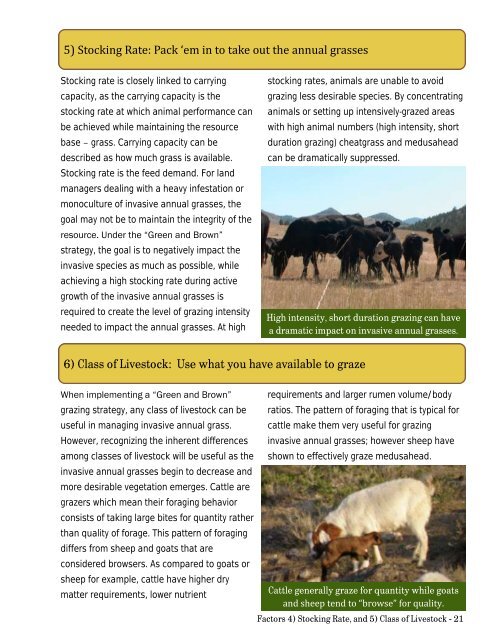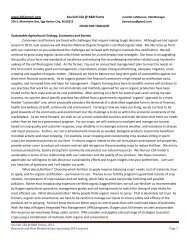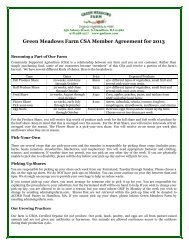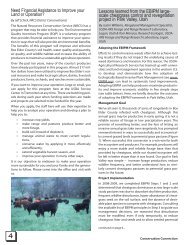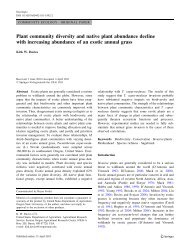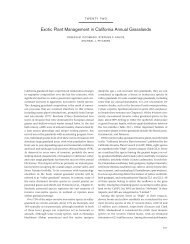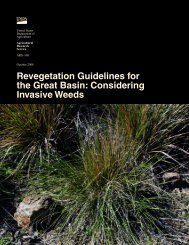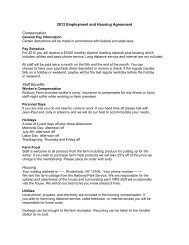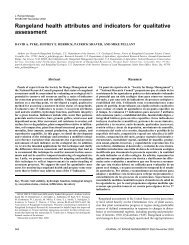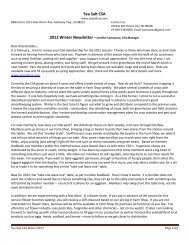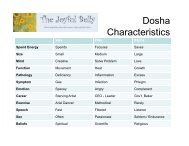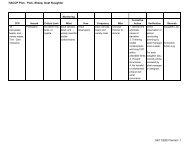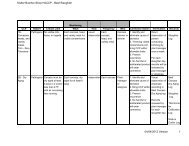“Green and Brown” Grazing Strategy
“Green and Brown” Grazing Strategy
“Green and Brown” Grazing Strategy
Create successful ePaper yourself
Turn your PDF publications into a flip-book with our unique Google optimized e-Paper software.
5) Stocking Rate: Pack ‘em in to take out the annual grasses<br />
Stocking rate is closely linked to carrying<br />
capacity, as the carrying capacity is the<br />
stocking rate at which animal performance can<br />
be achieved while maintaining the resource<br />
base – grass. Carrying capacity can be<br />
described as how much grass is available.<br />
Stocking rate is the feed dem<strong>and</strong>. For l<strong>and</strong><br />
managers dealing with a heavy infestation or<br />
monoculture of invasive annual grasses, the<br />
goal may not be to maintain the integrity of the<br />
resource. Under the <strong>“Green</strong> <strong>and</strong> <strong>Brown”</strong><br />
strategy, the goal is to negatively impact the<br />
invasive species as much as possible, while<br />
achieving a high stocking rate during active<br />
growth of the invasive annual grasses is<br />
required to create the level of grazing intensity<br />
needed to impact the annual grasses. At high<br />
stocking rates, animals are unable to avoid<br />
grazing less desirable species. By concentrating<br />
animals or setting up intensively-grazed areas<br />
with high animal numbers (high intensity, short<br />
duration grazing) cheatgrass <strong>and</strong> medusahead<br />
can be dramatically suppressed.<br />
High intensity, short duration grazing can have<br />
a dramatic impact on invasive annual grasses.<br />
6) Class of Livestock: Use what you have available to graze<br />
When implementing a <strong>“Green</strong> <strong>and</strong> <strong>Brown”</strong><br />
grazing strategy, any class of livestock can be<br />
useful in managing invasive annual grass.<br />
However, recognizing the inherent differences<br />
among classes of livestock will be useful as the<br />
invasive annual grasses begin to decrease <strong>and</strong><br />
more desirable vegetation emerges. Cattle are<br />
grazers which mean their foraging behavior<br />
consists of taking large bites for quantity rather<br />
than quality of forage. This pattern of foraging<br />
differs from sheep <strong>and</strong> goats that are<br />
considered browsers. As compared to goats or<br />
sheep for example, cattle have higher dry<br />
matter requirements, lower nutrient<br />
requirements <strong>and</strong> larger rumen volume/body<br />
ratios. The pattern of foraging that is typical for<br />
cattle make them very useful for grazing<br />
invasive annual grasses; however sheep have<br />
shown to effectively graze medusahead.<br />
Cattle generally graze for quantity while goats<br />
<strong>and</strong> sheep tend to “browse” for quality.<br />
Factors 4) Stocking Rate, <strong>and</strong> 5) Class of Livestock - 21


